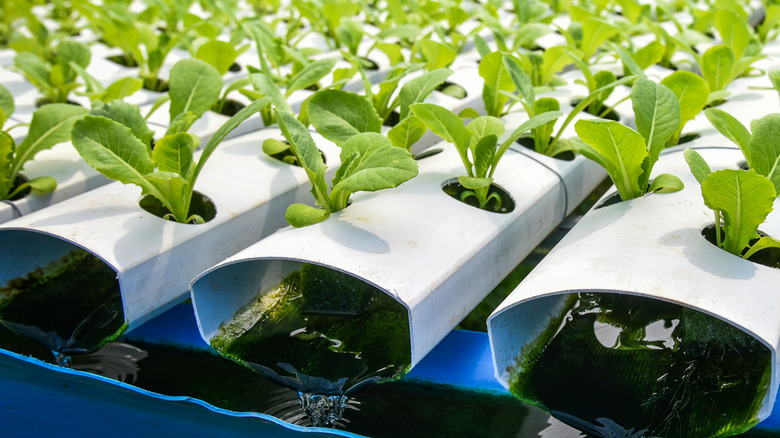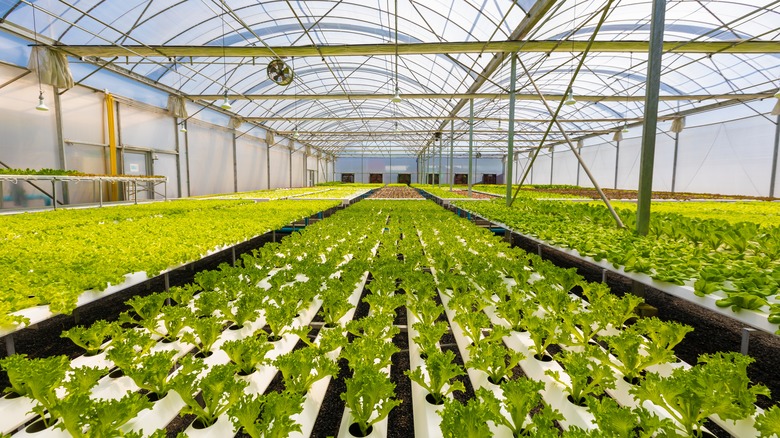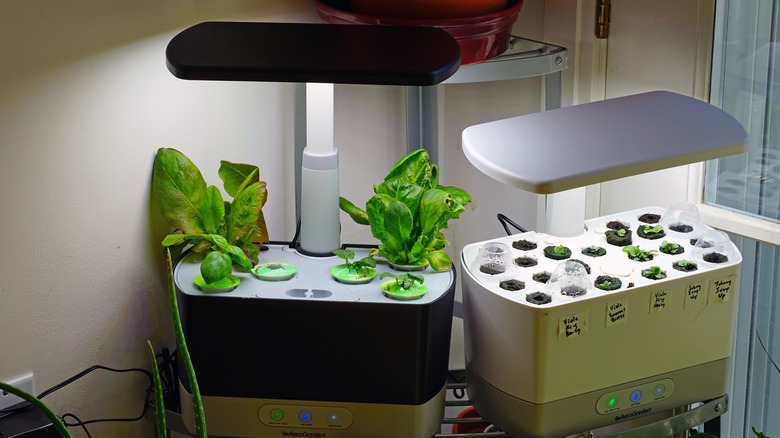What Is A Hydroponic Garden?
Hydro for water, and ponos for labor. These two Greek words come together to create the term hydroponic. In essence, that means all water and no soil. Oklahoma State University Extension goes on to explain that with a hydroponic garden comes many advantages, including the unexpected fact that plants grown in a soil-free, water-based system use less water than their counterparts growing out back in the dirt. This is due to the water going through a constant process of circulation and recycling. Hydroponic gardening also encourages faster plant growth, resulting in a higher harvest yield. Perhaps some of the best news is that these gardens lack weeds and attract significantly lower amounts of disease-promoting bacteria, fungi, and insects.
Large hydroponic setups have become somewhat common within the agricultural industry, but on a smaller scale, you can think of a hydroponic garden as an extension of your water propagation experiments. With proper attention and care, those rooted cuttings you dropped into a glass of water could have continued to grow whether or not you transplanted them into the soil.
Can plants really grow without soil?
Given the extraordinary volume of plants produced in a commercial-scale hydroponic growing system, the short answer here is a definitive yes; plants can grow without soil. But of course, there are caveats. Like all plants, those grown hydroponically still require proper nutrition, sunlight, protection from the elements, and the right air and water temperatures. One piece of the puzzle that is easy to overlook is oxygen, because even though it will be easy to access for the stems, foliage, and fruits, it's the roots that really need it. Hydroponic Way explains that both aeration and the circulation of water are essential to healthy plants.
All plants are capable of thriving without being planted in soil. However, you're likely to find that some do better than others. Various environmental conditions come into play as you figure out which plants are happy in the water and which would just as well be transplanted into the ground. For example, depending on the limitations of your setup, some edible plants that you can grow hydroponically may not have enough space to thrive. Butternut squash can spread 15 feet, and pumpkins require up to 100 square feet (via Survival Farm). On the flip side, mint is known to take over a backyard garden (if not the entire backyard) to the point of becoming invasive. Yet, in a hydroponic system, you'd be able to keep it contained, notes Plant Provider.
How to get started with hydroponic gardening
Getting started at home with a hydroponic setup is much easier than it may sound at first. As mentioned above, lettuce scraps from yesterday's salad left in a jar of water on the windowsill counts as hydroponic gardening. When you're ready to take the next step to something a bit more involved, countertop kits are available with grow lights installed. As long as you can spare a little space and access an electrical outlet, you won't even need to worry about exposure to natural light with these in place.
Once you've fallen in love with the process and can't imagine getting your hands dirty in the soil again, it'll be time to experiment with your own DIY hydroponic garden. With little more than a 5-gallon bucket, a standard aquarium filter, and an air hose, you can build a basic indoor or outdoor setup, according to No Soil Solutions. Whatever you decide to grow will likely flourish to a higher degree than what you've experienced in a regular soil-based garden plot. Be prepared with a trellis or something similar so that you'll be able to provide structural support to your new high-yield plants, and enjoy the fruits of your minimal amount of labor!


